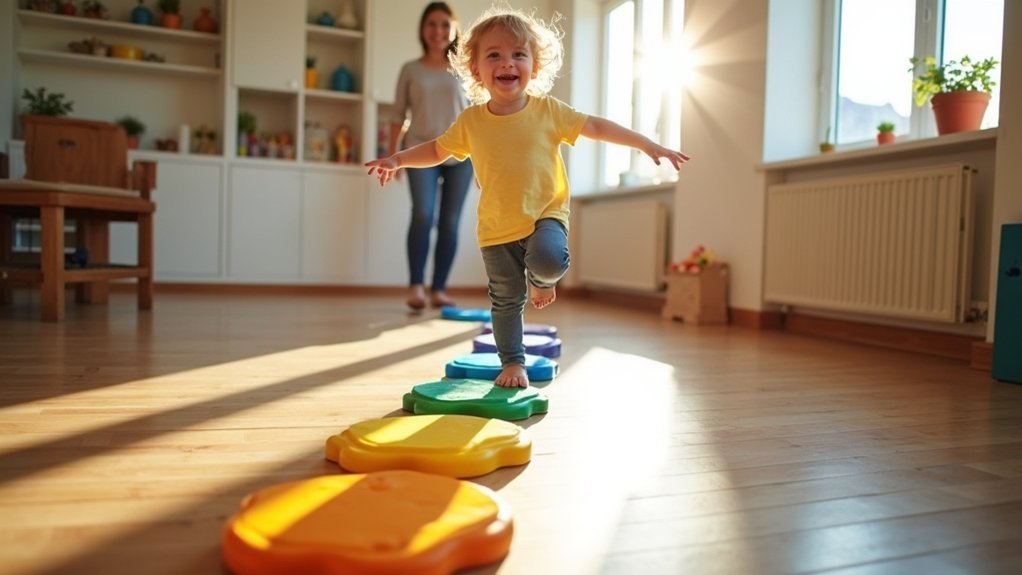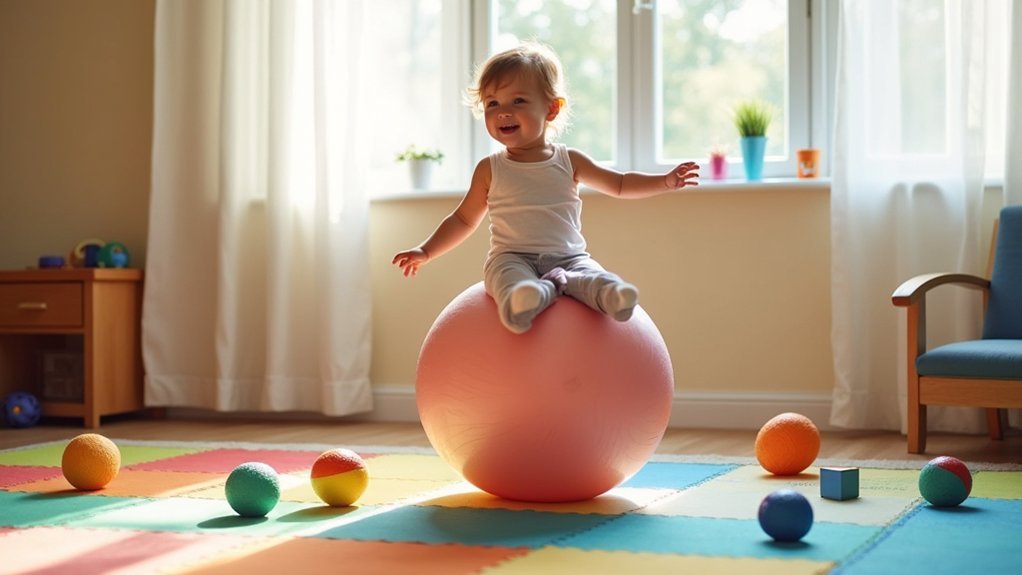Three key balance toys can greatly boost development for children with Down syndrome: balance stepping stones build core strength through colorful play on uneven surfaces; wobble boards enhance body awareness and coordination through continuous movement challenges; and therapy balls improve gross motor skills while making exercise fun. You’ll see notable improvements in your child’s balance, confidence, and ability to participate in daily activities. Discover how these simple tools create pathways to developmental milestones.
Balance Stepping Stones: Developing Core Strength Through Play

Colorful stepping stones scattered across the floor create more than just an exciting playground—they’re powerful tools for developing essential physical abilities in children with Down syndrome.
As your child navigates these balance stepping stones, they’re actively building core strength by stabilizing their body across uneven surfaces.
You’ll notice improved motor planning skills as they learn to shift weight and coordinate movements between stones. This deliberate practice enhances proprioception—their body’s awareness in space—which is vital for physical development.
What makes these tools exceptional is their adaptability across developmental stages. You can adjust the challenge by changing stone placement or height, making them suitable for children of different abilities.
Through this engaging play, your child enjoys active movement while developing the strength and coordination they need.
Wobble Boards: Enhancing Proprioception and Body Awareness
Wobble boards stand out as remarkable tools for children with Down syndrome because they provide continuous balance challenges that directly enhance proprioceptive development. You’ll notice improved body awareness as your child learns to adjust their position on the unstable surface, strengthening neural pathways essential for movement.
| Benefit | How Wobble Boards Help |
|---|---|
| Core Strength | Constant stabilization activates abdominal and back muscles |
| Coordination | Requires synchronized movements between upper and lower body |
| Motor Planning | Teaches anticipation of movement consequences |
| Social Skills | Enables cooperative play with peers or caregivers |
| Developmental Goals | Provides measurable progress in balance milestones |
Therapy Balls: Multi-Sensory Balance Training for Daily Skills

Versatile therapy balls offer a powerful combination of play and purposeful development for children with Down syndrome.
They’re specifically designed to enhance core strength while providing the sensory integration your child needs through tactile feedback during active movement.
You’ll notice improvements in your child’s balance and coordination as they bounce, sit, and roll on these colorful spheres. Each interaction helps develop critical gross motor skills while building body awareness and spatial orientation—foundational elements for mastering daily living tasks.
The beauty of therapy balls lies in their ability to make therapeutic exercise feel like play.
As your child engages with these tools regularly, they’ll develop greater confidence and independence in movement, ultimately supporting their participation in social activities and everyday routines.
Frequently Asked Questions
What Are the Balance Exercises for Down Syndrome?
You can help children with Down syndrome improve balance through standing on one leg, traversing balance beams, practicing hopping, joining yoga sessions, and playing catch while balancing. These build core strength and coordination.
What Toys Are Good for Babies With Down Syndrome?
You’ll find balance toys, sensory balls, ride-on toys, soft stacking blocks, and push toys are excellent for your baby with Down syndrome. They’ll help develop core strength, coordination, and sensory skills during playtime.
What Is Stimming in Down Syndrome?
Stimming in Down syndrome refers to repetitive self-soothing behaviors you’ll notice like rocking, hand-flapping, or making sounds. It’s how your child might regulate sensory input, manage anxiety, or express emotions when feeling overwhelmed.
What Increases Down Syndrome?
Advanced maternal age considerably increases your risk of having a child with Down syndrome, especially after age 35. You’ll also face higher risks if you’ve previously had a baby with this genetic condition.
In Summary
You’ve discovered powerful tools to support your child’s developmental journey. Balance stones, wobble boards, and therapy balls aren’t just toys—they’re stepping stones to improved coordination, strength, and confidence. By incorporating these balance toys into daily play, you’re helping your child with Down syndrome build essential motor skills that’ll support their independence. Remember, consistency is key—make balance play a fun, regular part of your routine.





Leave a Reply